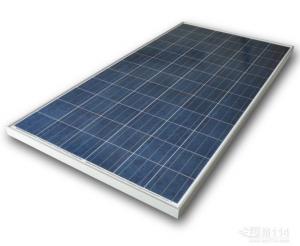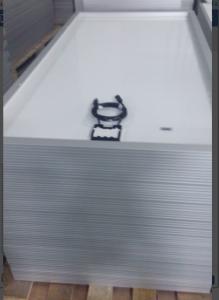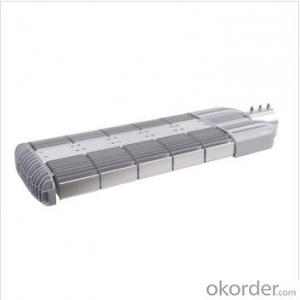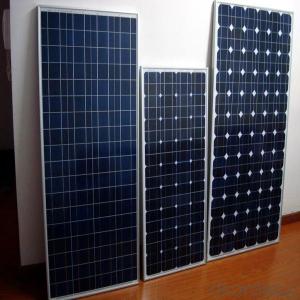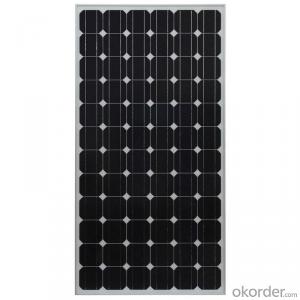Oklahoma Solar Panels - Mono 220W Solar Panels Made in China for Sale
- Loading Port:
- Shanghai
- Payment Terms:
- TT OR LC
- Min Order Qty:
- 10000 watt
- Supply Capability:
- 1000000 watt/month
OKorder Service Pledge
Quality Product, Order Online Tracking, Timely Delivery
OKorder Financial Service
Credit Rating, Credit Services, Credit Purchasing
You Might Also Like
Specification
Material:
Monocrystalline Silicon
Max. Power(W):
220
Number of Cells(pieces):
72
Product Description

Specifications:
| Type of cell | mono |
| Max. power (Wp) | 180-220W |
| Max. power voltage (V) | 37V |
| Max. power current (A) | 5.5A |
| Open circuit voltage (V) | 44.6V |
| Short circuit current (A) | 6A |
| Number of cells (Pcs) | 72 |
| Size of module (mm) | 1580*808*35mm |
| Max. system voltage (V) | 1000 |
| Temperature coefficients of Isc (%) | + 0.1/ °C |
| Temperature coefficients of Voc (%) | -0.38/ °C |
| Temperature coefficients of Pm (%) | -0.47/ °C |
| Tolerance Wattage (e.g. +/-3%) | +/-3% |
| Surface Max. Load Capacity | 60m/s(200kg/sq.m) |
| Weight per piece (kg) | 16kg |
| Junction Box Type | 4m, length 1000MM,TUV |
| Connectors and Cables Type | MC4 |
| Output Cables (mm) | φ=4mm², L=900mm |
| Cell Efficiency (%) | ≥18.6% |
| Output tolerance (%) | +/-3% |
| Frame (Material, Corners, etc.) | Aluminum |
| Front Glass | 3.2mm high transmission, Low Iron, Tempered Glass |
| Warranty | 10Years products warranty and 25 years 80% of power |
| Standard Test Conditions | AM1.5 1000mW/cm2 25°C |
| FF (%) | 72% |
| Operating temperature ºC | -40 ºC ~+85 ºC |
Packaging:
2pcs/carton, 310pcs/20GP
Advantages
1.Long Service Life
2.High Efficiency Solar Cells
3.Special Aluminum Frame Design
4.High Transmission, Low Iron Tempered Glass
5.Advanced Cell Encapsulation
Solar Panel Application:
1. Solar power station, field operation some huge engineer construction;
2. Living house and home building;
3. Office building, factory and warehouse;
4. other industrial and commercial applications.
- Q: I'm looking to mount a solar panel to the top of my 2003 Pontiac Montana and was wondering how i could do it without any screws? Magnets maybe?
- What mark said about shade is true, but take into account that the solar panel will absorb most of that heat. That is how they work they absorb the energy (heat) from the sun and transfer it into useable power.
- Q: When you add a load resistor to a PV panel (Solar panel) of 00 ohms what happens to the voltage produced from the cellAlso, as the resistance increases, how does this affect the output voltage
- Look at the graph data that looks like a rotated L. That is what voltage as a function of current characteristically behaves. The highest voltage value is called open circuit voltage (Voc). The current at lowest voltage value is called short circuit current (Isc). If you notice, a second curve is plotted that looks like a hill. That curve is power output as a function of voltage. At the peak of said hill, you get the most utility of your PV module, as you output the maximum power possible, and that is the nameplate value for the PV module's power rating.
- Q: Can solar panels be installed on a canopy or pergola?
- Yes, solar panels can be installed on a canopy or pergola. In fact, these structures can provide an ideal location for solar panel installation as they are often situated in areas with good sun exposure. By placing solar panels on canopies or pergolas, you can maximize the use of available space while also providing shade and protection from the elements.
- Q: Can u guys help on how solar panels work and how it generates electricity?(or u can give me a good website that has solar panel info on it)~Thanks in advance!~
- Solar okorder under products that are sorted by watts per area. Also go to wikipedia to get more detailed information on solar cells.
- Q: I made three 36 solar cell (3x6 .5V 3.5A) panel and had it hooked a up to an old car inverter. I was on line looking for a cheap grid tied inverter. I came across the Enphase micro inverter and was wondering if i could use one of those. Will it work?
- Have okorder . It might truly benefit anyone!
- Q: How do solar panels affect the value of a home?
- Solar panels can significantly increase the value of a home. They offer long-term cost savings on electricity bills and can generate additional income through net metering or selling excess energy back to the grid. Additionally, solar panels are environmentally friendly, which appeals to many buyers and can make a property more attractive in the market.
- Q: Can solar panels power my entire home?
- Yes, solar panels can potentially power your entire home depending on various factors such as the size of your system, energy consumption, and geographical location. It is important to assess your energy needs, install an appropriately sized solar system, and consider factors like sunlight availability to ensure sufficient power generation.
- Q: Are solar panels fire hazards?
- Solar panels are generally safe and do not pose a significant fire hazard. However, like any electrical system, there is a small risk of fire if there are installation errors, damaged wiring, or improper maintenance. Proper installation and regular inspection can minimize these risks and ensure the safe use of solar panels.
- Q: Where in the world are solar panels used. If it is used widespread across a continent just say which continent, other than that, just name the country. So where are solar panels used often?
- Many okorder /... I have friends in Northern Michigan who use solar panels and wind generator for all their energy. They have been doing it for almost 20 years.
- Q: How do you make solar panels and do you need a lot of them to make electricity?
- Have okorder . It could obviously explain everybody!
Send your message to us
Oklahoma Solar Panels - Mono 220W Solar Panels Made in China for Sale
- Loading Port:
- Shanghai
- Payment Terms:
- TT OR LC
- Min Order Qty:
- 10000 watt
- Supply Capability:
- 1000000 watt/month
OKorder Service Pledge
Quality Product, Order Online Tracking, Timely Delivery
OKorder Financial Service
Credit Rating, Credit Services, Credit Purchasing
Similar products
Hot products
Hot Searches










